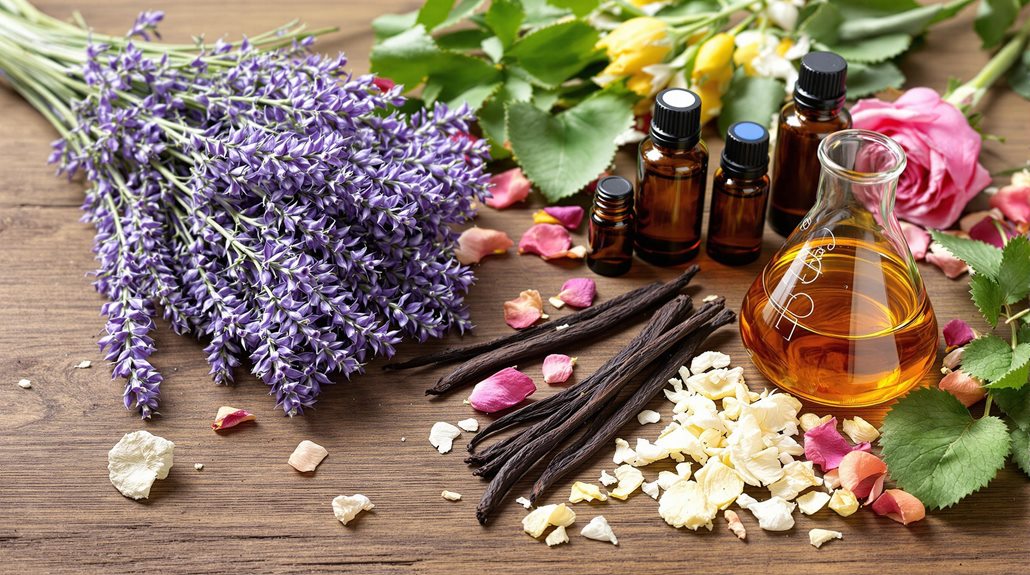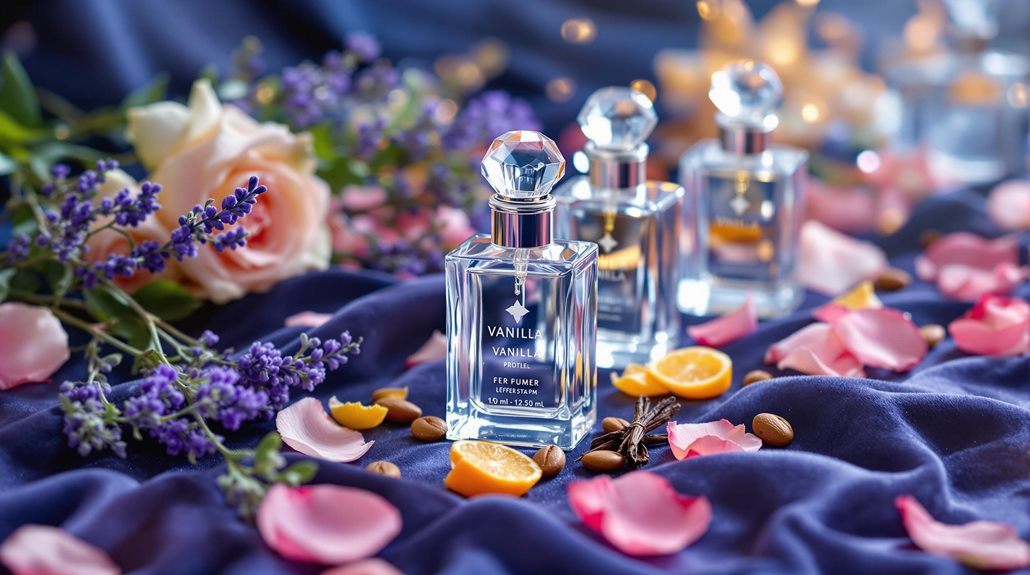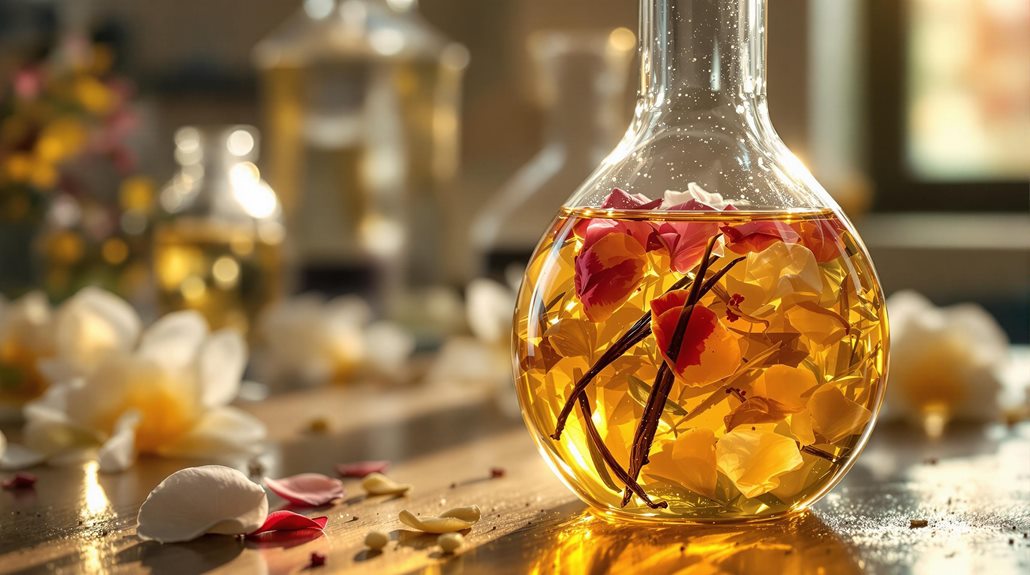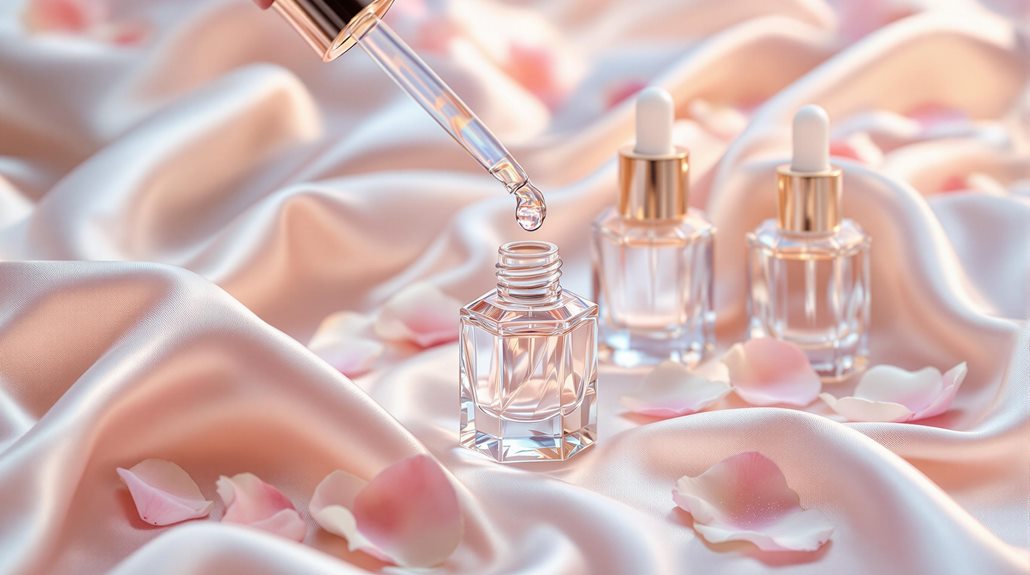How to Make Perfume: A DIY Guide to Crafting Your Own Fragrance
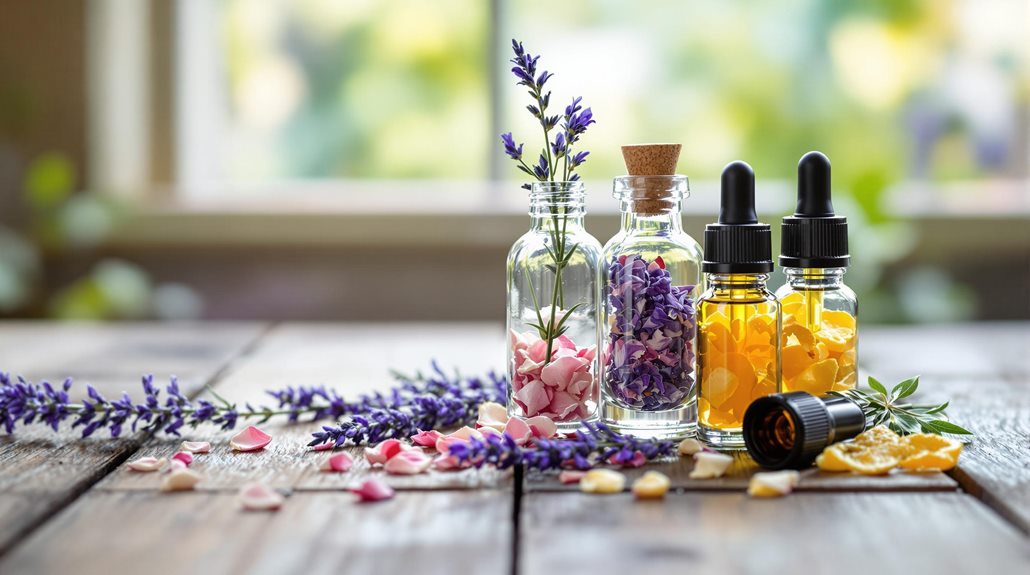
Creating your own signature perfume starts with understanding the three essential fragrance layers: top, middle, and base notes. You'll need high-proof alcohol as a carrier, essential oils for fragrance, and glycerin for stability. Begin by selecting complementary scents following the 30-30-30 rule: 30% each of base, middle, and top notes. Mix your chosen oils with the alcohol base, starting with deeper base notes like vanilla or amber, then adding floral middle notes and fresh top notes. Let your creation rest for at least 48 hours to allow the scents to blend properly. Excelling in the art of perfumery requires understanding a few more key techniques and principles.
Understanding Perfume Composition
When you're creating your own perfume, understanding its composition is like building a pyramid of scents. The structure consists of three distinct layers of fragrance notes that work together to create a harmonious blend. Each layer serves a specific purpose in your perfume's development and lasting power.
Your perfume adventure begins with top and middle notes. The top notes are the first scents you'll notice when applying your perfume, typically consisting of light, fresh essential oils like citrus or spicy aromas. These volatile scents create an immediate impression but fade quickly. The middle notes emerge as the top notes dissipate, forming the heart of your fragrance. These are often floral scents that define your perfume's main character.
The foundation of your perfume rests on the base notes, which are the longest-lasting perfume ingredients. They're usually rich, deep scents like woody or musky essential oils that anchor the entire composition. When you're blending these three layers, remember that the ratio between your fragrance notes matters remarkably. You'll need to carefully balance each layer to create a well-rounded perfume that shifts seamlessly from one note to the next.
Essential Tools and Materials
A perfume-making toolkit requires several essential items before you can start creating your signature scent. You'll need high-proof alcohol, such as vodka or Everclear, which acts as a carrier for your fragrances and helps prevent bacterial growth. Essential oils, fragrance oils, or infused oils will provide the aromatic components of your perfume, while glycerin helps stabilize the mixture and enhances its longevity.
For proper measurement and mixing, you'll want to gather glass bottles for storage, measuring cups and spoons for precise proportions, and droppers for careful dispensing of oils. A funnel will help you transfer your perfume mixture without spills. Make sure to use spring or distilled water, as tap water may contain impurities that could affect your perfume's quality.
Before you begin mixing your fragrance, it's of utmost importance to sterilize all your glass bottles and containers. Running them through the dishwasher is an effective method to confirm they're thoroughly clean and free from any contaminants that could compromise your perfume. Keep these tools dedicated to perfume-making to maintain their sterility and prevent cross-contamination.
The Science of Fragrance Notes
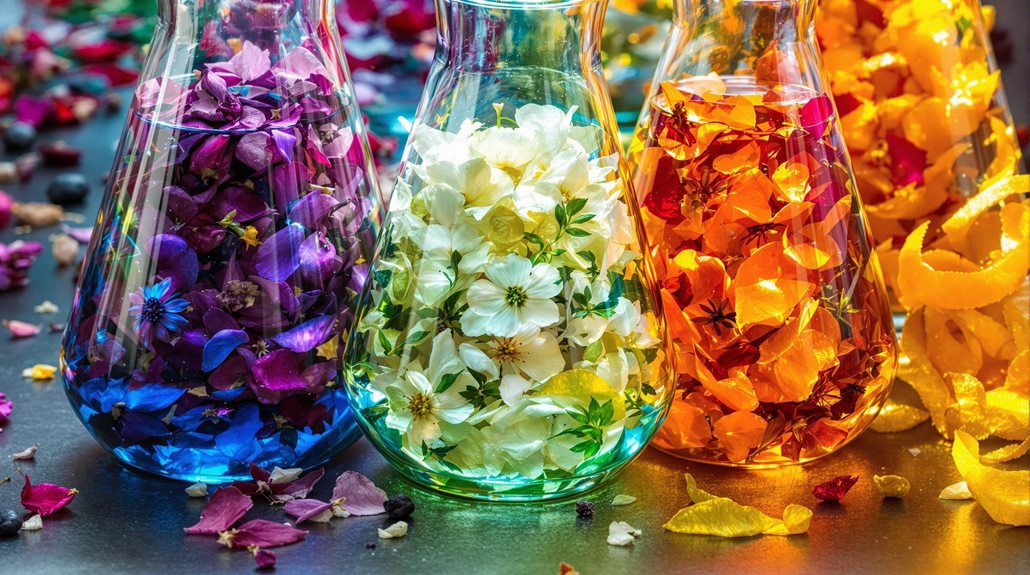
Understanding fragrance notes is essential for creating a well-balanced perfume that evolves beautifully on your skin. When you're working with essential oils and fragrance oils, you'll need to pick how each note category contributes to your final creation.
Top notes are the first scents you'll detect in your perfume, typically lasting 15-30 minutes. You'll want to include bright, fresh oils like citrus or light herbs to produce an immediate impact. Your middle notes form the heart of your fragrance, emerging as the top notes fade. These often include floral or spicy essential oils that provide the signature character of your perfume.
Base notes are the foundation that helps your fragrance last longer. You'll find these deeper, richer scents becoming more prominent after several hours of wear. When selecting your oils, aim for a ratio of approximately 30% top notes, 50% middle notes, and 20% base notes. This balance facilitates your perfume developing properly over time. Remember that each oil you choose should complement the others, creating a harmonious blend that moves smoothly between note categories as the fragrance develops on your skin.
Selecting Your Signature Scents
Now that you grasp how fragrance notes work together, finding your perfect scent combination becomes an exciting trek of self-expression. Start by identifying your preferred scent profile - whether you're drawn to woodsy aromas, fresh citrus, delicate florals, or deep musky notes. This initial preference will guide your selection of fragrance oils and help create a signature scent that truly represents you.
When selecting your essential oils and fragrance oils, follow the 2-1-1 ratio rule: two parts base notes, one part heart notes, and one part head notes. Choose long-lasting base notes like sandalwood or vanilla as your foundation. Then, add heart notes such as jasmine or rose to create the perfume's main character. Finally, incorporate head notes like grapefruit or bergamot to deliver that initial burst of fragrance.
Don't hesitate to experiment with different combinations until you find your perfect blend. Test each mixture on your skin, as fragrances can react differently with your body chemistry. This verifies your signature scent not only smells great in the bottle but also works harmoniously with your natural essence.
Blending and Layering Techniques
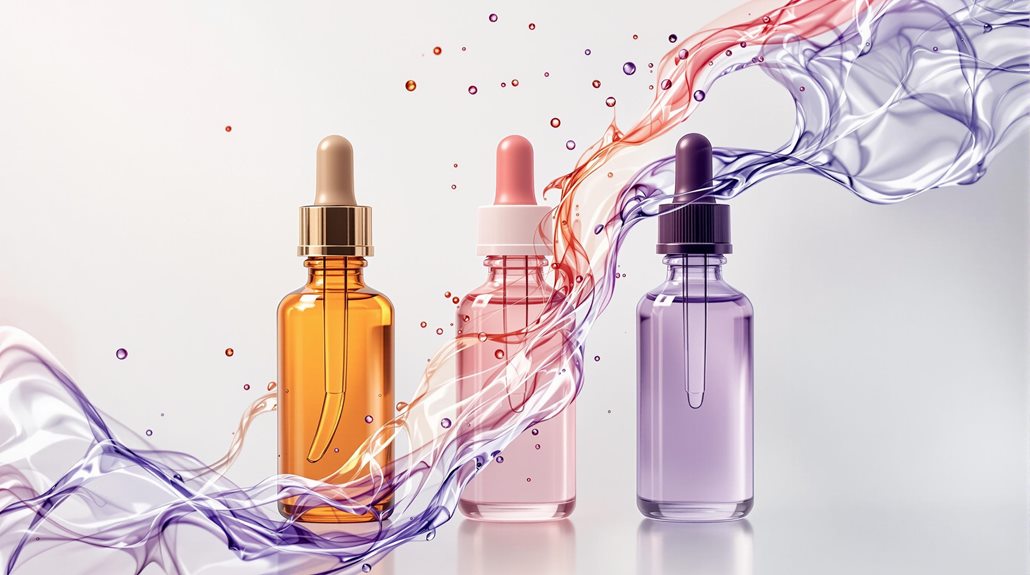
Commanding three essential techniques will raise your DIY perfume creation: proper dilution, careful layering, and strategic blending. Start by diluting your fragrance oils with a carrier oil, typically at a 15-30% concentration for perfume oil. This prevents the scents from becoming overwhelming and helps them blend harmoniously.
When layering, you'll want to build your fragrance in stages. Begin with base notes, which are heavier and longer-lasting. Wait 15 minutes, then add your middle notes, followed by top notes after another short interval. This method allows each layer to settle and bond with your skin chemistry.
For strategic blending of essential oils or fragrance oils, follow the 30-30-30 rule: combine 30% base notes, 30% middle notes, and 30% top notes, leaving 10% for special accent notes. You'll need to experiment with different ratios to achieve your desired fragrance blends. Use small test batches and document your combinations carefully. When mixing, stir gently and let your creation rest for at least 48 hours to allow the scents to marry properly. This patience will result in more sophisticated and balanced fragrance blends.
Carrier Oils and Bases
The right carrier oil or base forms the foundation of your DIY perfume and determines how your fragrance will interact with your skin. When choosing your base, you'll need to ponder the type of perfume you want to create and how you plan to apply it.
If you're looking for a lightweight, natural option, jojoba oil and sweet almond oil are excellent choices. These carrier oils won't compete with your fragrance notes and will absorb quickly into your skin without leaving a greasy residue. For a more traditional perfume that projects well, alcohol-based formulations using vodka or Everclear work best. The alcohol helps your fragrance evaporate quickly, creating a stronger scent presence. You can add glycerin to your alcohol base to prevent the formula from being too drying and achieve a smoother consistency.
For a lighter concentration like eau de toilette or cologne, consider using distilled water to dilute your fragrance oils. You'll want to choose your base carefully, as it affects not only how long your perfume lasts but also how it develops on your skin throughout the day.
Creating Your First Fragrance
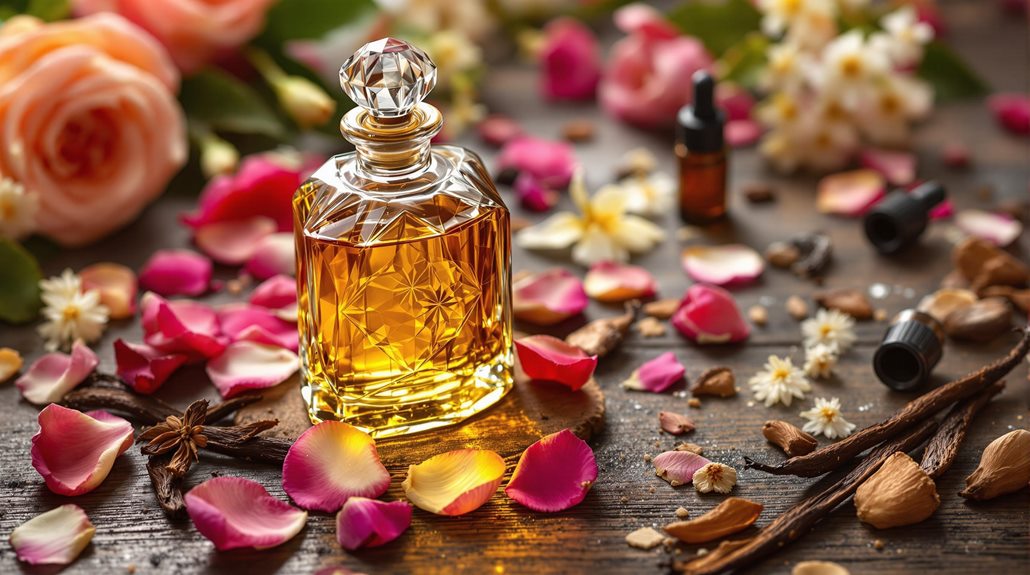
Once you've selected your ideal base, building your signature scent becomes an exhilarating expedition of layering complementary fragrances. When making a perfume, you'll want to start with a strong foundation like vanilla, amber, or sandalwood mixed with your carrier oil or perfumer's alcohol. These base notes create the lasting impression of your homemade perfume.
Next, introduce your middle notes, which form the heart of your fragrance. Select oils like rose, jasmine, or lavender to add depth and character. These notes bridge the gap between your base and top notes, creating a harmonious blend. For the finishing touch, incorporate lively top notes such as citrus, herbs, or spices that'll provide that initial burst of scent when applied.
Keep your first creation simple by combining just 2-3 oils. This approach allows you to understand how different scents interact and helps you develop your perfume-making skills. Once you've mixed your oils, remember to let your creation rest for at least 48 hours. This important resting period allows the fragrance notes to meld together, resulting in a more refined and balanced scent profile.
Aging and Storage Methods
Proper aging and storage will determine whether your homemade perfume maintains its intended fragrance profile. Once you've blended your fragrance, you'll need to let it age for 4-6 weeks. During this aging period, the different scent notes will harmonize and develop their full potential, creating a more balanced and sophisticated perfume.
To store your creation, pick a dark place away from direct sunlight and heat sources. You'll want to use glass bottles with secure, airtight lids to prevent your perfume from oxidizing or evaporating. While alcohol as a carrier in your perfume blend helps preserve the scent initially, you can extend its life even further by adding a few drops of pure grain alcohol annually.
When stored correctly, your perfume can remain stable for years. Remember to keep your bottles tightly sealed when not in use, as exposure to air can alter the fragrance. If you notice any changes in color or scent, or if the perfume becomes cloudy, it's time to create a fresh batch. By following these storage guidelines, you'll maintain your handcrafted perfume as alluring as the day you made it.
Perfecting Your Recipe
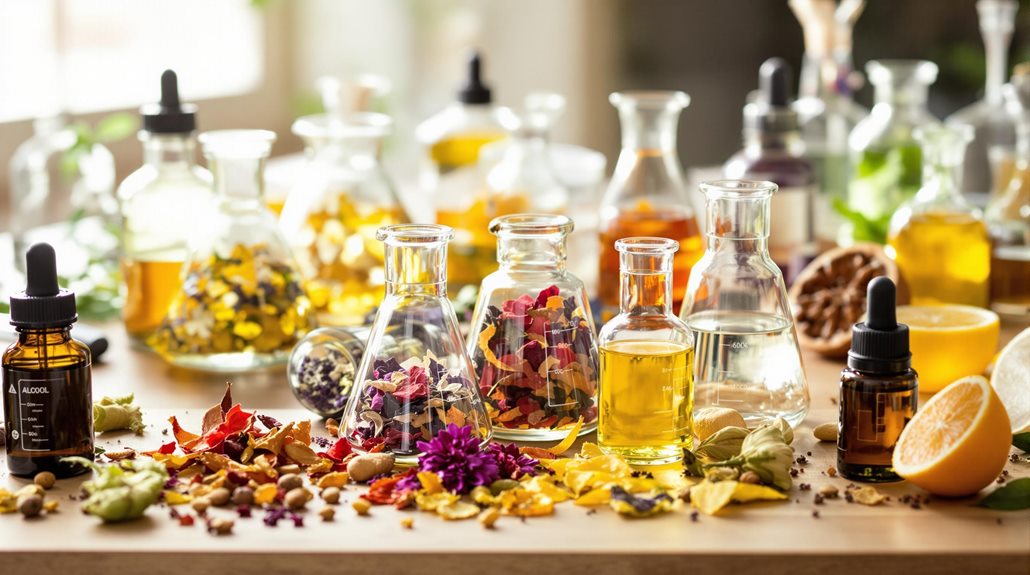
Creating your signature perfume recipe requires patience and methodical experimentation. To start making your perfect blend, keep detailed notes of every combination you try, including exact measurements and your impressions of each result. Begin with small batches to avoid wasting precious perfume oils if a mixture doesn't work out.
Start experimenting with three to four oils maximum, and make sure you understand how each note will develop over time. You'll want to smell your creation at different stages: immediately after blending, after an hour, and after a full day. This helps you gauge how the fragrance evolves and whether it maintains the character you're seeking.
Test your perfume on paper strips first, then on your skin, as body chemistry can drastically affect how a scent develops. Adjust your recipe gradually, changing only one element at a time so you can track what works and what doesn't. Remember that the ideal ratio for perfume oils is typically 15-30% oils to 70-85% carrier base. Once you've found a combination you love, scale up the recipe carefully, maintaining exact proportions to achieve consistency in your final product.
Conclusion
You've now learned the fundamentals of crafting your own signature perfume. With practice, you'll become an expert in the art of blending fragrances, understanding scent profiles, and creating unique combinations. Don't be afraid to experiment with different notes and ratios until you find your perfect mix. Remember to keep detailed notes of your successful formulas, and you'll soon be creating professional-quality perfumes from your home workspace.

